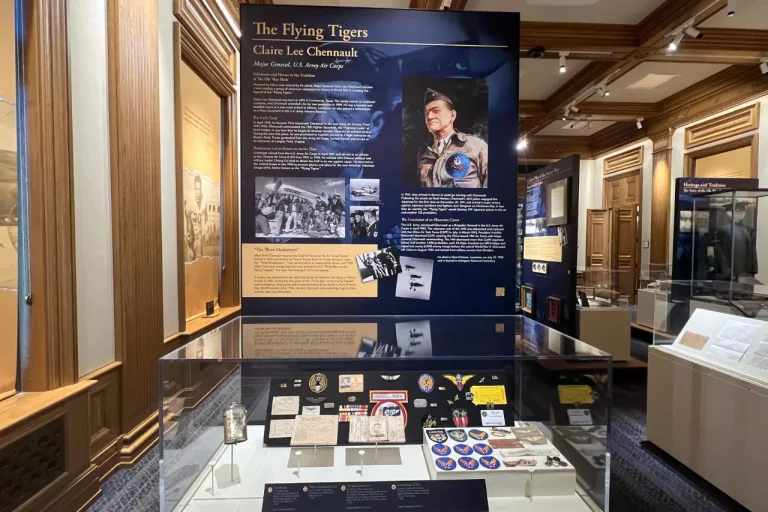Have you ever wondered about the stories behind historic military artifacts or the personal tales of bravery from soldiers of the past? Exploring the rich military heritage at LSU Military Museum offers not only a peek into the past but an immersive experience that connects us deeply with history. Nestled within the heart of Louisiana State University, this museum is a treasure trove waiting to be discovered.
Located on the LSU campus, the LSU Military Museum Official Website provides detailed information about exhibits and visiting hours. It’s not just a museum; it’s a gateway to understanding the profound impact LSU has had on military history.
Table of Contents
History of the LSU Military Museum

The Founding and Establishment
The story of the LSU Military Museum is as rich as the heritage it preserves. Established to honor and commemorate the valor and sacrifices of military personnel, the museum has become a cornerstone for military history exploration in Louisiana. LSU’s military heritage dates back to its origins, and the museum plays a pivotal role in showcasing this legacy.
Role in Preserving Military History
Over the years, the museum has dedicated itself to collecting and safeguarding military artifacts and personal stories. Through collaborations with veterans and their families, it has amassed a remarkable collection that highlights the military contributions of LSU alumni and the broader Louisiana community.
The Significance of LSU’s Military Heritage



LSU’s Origins as a Military Institution
Did you know that Louisiana State University was originally founded as a military academy? The Louisiana State Seminary of Learning & Military Academy was established in 1853, laying the groundwork for LSU’s long-standing military traditions. This foundation has profoundly influenced the university’s culture and its commitment to service.
Contributions to U.S. Military History
LSU’s impact on U.S. military history is both significant and inspiring. From training officers during pivotal wars to producing notable military leaders, the university’s role cannot be overstated. Alumni have served with distinction in various conflicts, and their stories are integral to the rich tapestry of American military heritage.
A Family’s Story of Sacrifice and Service
One of the most poignant exhibits in the museum is that of Kim Carroll and her father, Grant Stewart. Kim never had the chance to meet her father. Just days after her birth in 1969, Stewart, a US Air Force cadet and LSU graduate, was shot down in Vietnam and remains missing in action.
Standing beside a display that honors her father, Kim shares personal treasures: letters penned by her father to her mother, military patches, and personal belongings that once sat quietly in boxes. “I would rather have everyone else enjoy it,” she reflects. “I think the legacy would live on more here than in a box.”
Her decision to donate her father’s memorabilia was inspired by her husband, Gary Carroll, himself a military veteran who served in Iraq and also an LSU graduate. Remarkably, Gary’s uniform now stands alongside that of his father-in-law, a man he never met but feels closely connected to. “To be part of that tradition, not just the tradition of the military but the tradition of LSU, is a great honor,” Gary expresses.
Honoring Notable Military Figures from LSU
The museum doesn’t just recount events; it tells the stories of remarkable individuals who walked LSU’s halls and went on to make significant impacts.
General Claire Chennault and the Flying Tigers
Many might be surprised to learn that General Claire Lee Chennault was an LSU graduate. He commanded the famous Flying Tigers, a group of American volunteer pilots who gained fame for their defense of China during World War II. Their aircraft, adorned with distinctive shark-head designs, became iconic symbols of courage and innovation.Chennault named his squadron the Flying Tigers, inspired by his association with LSU. Today, they’re one of the most recognizable units in Air Force history.
General Troy Middleton: From LSU to the Battlefields
Another prominent figure is General Troy Middleton. Serving as commandant and later president of LSU, Middleton’s military career is storied. During World War II, he was credited with holding Bastogne during the infamous Battle of the Bulge, a pivotal moment in the war. His leadership and tactical acumen are celebrated both on campus and within the museum.
A Heroic Rescue Tied to a Future President
The museum also highlights the story of Bill Edwards, who served aboard the USS Finback submarine during World War II. During a mission, they rescued a downed pilot who would later become President George H.W. Bush. Tales like these weave together the fabric of LSU’s military heritage with broader national history.
Living Legacies and Personal Connections
While many view museums as mere repositories of the past, the LSU Military Museum emphasizes living legacies—stories of those still with us, and those who continue to inspire.
Modern-Day Heroes and Contributions
The museum showcases items like the crown of Rachel Sherburn, an LSU homecoming queen who served a tour of duty in Iraq. Such exhibits highlight the ongoing commitment of LSU students and alumni to serve their country.Walking through the exhibits, you’ll notice LSU stickers on military helmets and armored tanks—a testament to Tiger Pride reaching even the most remote and dangerous parts of the world.
The Heart of the Museum: Personal Donations
“Almost everything you see here comes from families,” shares a museum representative. The museum thrives on the personal stories and artifacts donated by those connected to LSU. They’re always seeking more donations, especially stories that bring history to life.”We love stories here at the museum,” they emphasize. It’s this personal touch that sets the LSU Military Museum apart, making it a place of connection, reflection, and pride.
Exhibits Showcasing the Rich Military Heritage



World War I and the Memorial Tower
One of the museum’s most iconic features is the Memorial Tower, a monument dedicated to the LSU students who served in World War I. Walking through this exhibit, you’ll find yourself immersed in personal letters, photographs, and artifacts that bring to life the experiences of those who bravely served.
Highlights include:
- Authentic uniforms worn by soldiers.
- Weapons and equipment used during the era.
- Interactive displays that provide historical context.
World War II Exhibits
The World War II section pays homage to the heroic efforts of LSU alumni who contributed to the war efforts. Interactive displays and multimedia presentations offer a deeper understanding of the strategies, challenges, and triumphs experienced during this pivotal time in history.
Key features:
- Stories of medal recipients and their courageous acts.
- Multimedia exhibits that showcase significant battles.
- Personal diaries and letters offering intimate glimpses into the past.



Interactive Experiences at the Museum
Exploring the LSU Military Museum isn’t just about viewing exhibits; it’s an engaging experience that connects you with history on a personal level.
Guided Tours and Educational Programs
If you visit, the museum’s guided tours offer in-depth insights. Knowledgeable guides share fascinating stories behind the artifacts, and educational programs are available for schools and groups.
Interactive Displays and Technology
Modern technology meets history with interactive displays that make learning both fun and memorable. From virtual reality experiences to hands-on exhibits, visitors of all ages can immerse themselves in the military heritage exploration.
Preservation of Personal Stories and Artifacts
Donations from Veterans and Families
The heart of the museum lies in the personal stories and artifacts donated by veterans and their families. These contributions are invaluable, adding depth and authenticity to the exhibits.
- Personal letters and photographs that chronicle individual experiences.
- Medals, uniforms, and military artifacts that tell tales of bravery.
The Importance of Personal Narratives
By preserving these personal narratives, the museum ensures that future generations understand the sacrifices made by those before them. It’s a touching reminder of the human side of war and the enduring spirit of those who served.
Educational Impact and Community Involvement
Programs for Students and Researchers
The LSU Military Museum isn’t just a static display; it’s a living educational resource. Programs are tailored for students and researchers interested in delving deeper into military history.
- Access to archives for scholarly work.
- Internship and volunteer opportunities for hands-on experience.
Community Events and Partnerships
Engaging with the community is a cornerstone of the museum’s mission. Regular events, workshops, and partnerships with local organizations foster a shared appreciation for the region’s military heritage.
Visiting the LSU Military Museum
Planning a visit? Here’s what you need to know to make the most of your experience.
Location and Hours of Operation
The museum is conveniently located on the LSU campus, making it easily accessible for both locals and visitors.
- Address: Louisiana State University, Baton Rouge, LA
- Operating Hours: Check the LSU Military Museum Official Website for the most current information.
Admission Details and Visitor Information
Admission details are straightforward, and the museum is committed to being accessible to all.
- Admission Fee: Free (donations are welcome)
- Accessibility: The museum is wheelchair accessible and accommodates visitors with special needs.
The Enduring Legacy of LSU’s Military Heritage
Exploring the rich military heritage at LSU Military Museum is more than a tour; it’s an immersive journey that connects us with the courage and sacrifices of those who served. By delving into the exhibits and stories preserved here, we gain a deeper appreciation for the past and inspiration for the future.Whether you’re a student, a history enthusiast, or someone looking to connect with profound stories of military service, the museum offers an unforgettable experience. So why not plan a visit and be a part of the living history that continues to shape our understanding of bravery and dedication?
Frequently Asked Questions About LSU Military Museum
What are the LSU Military Museum’s operating hours?
The museum is typically open Monday through Friday from 9 AM to 4 PM. It’s always a good idea to check the official website for any changes in hours or holiday closures.
Is there an admission fee for the museum?
Admission to the LSU Military Museum is free, although donations are greatly appreciated to help maintain the exhibits and programs.
Can I donate artifacts or personal stories to the museum?
Absolutely! The museum welcomes donations of military artifacts and personal accounts. Interested individuals can contact the museum directly to discuss the donation process.
Are photography and videography allowed inside the museum?
Yes, visitors are encouraged to take photos and share their experiences. However, the use of flash photography may be restricted in certain areas to preserve sensitive artifacts.
Explore More Posts About Louisiana Legacy
Natchitoches Louisiana Christmas Festival: A Holiday Must-See
Explore Natchitoches Historic American Cemetery in Louisiana
Shadows on the Teche: Louisiana’s Antebellum Tourism
Journeying the Great River Road: South Louisiana Highlights
The National Hansen’s Disease Museum
8 Cultural Experiences & Museums in Louisiana You Can’t Miss
Disclosure Policy
Some links in this post contain affiliate links. Meaning if you click through and make a purchase, I may earn a small commission at no additional cost to you. Your support means a lot to me and helps me to keep creating and maintaining the quality of this site for you.


































